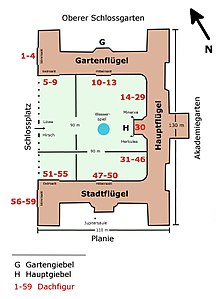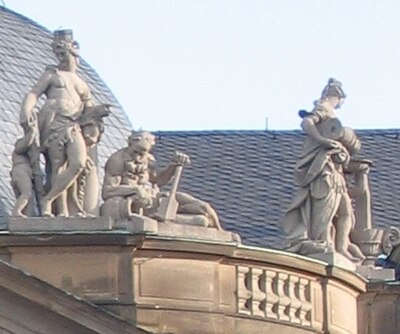Main gable (New Palace Stuttgart)
The main gable of the New Palace in Stuttgart forms the end of the central building of the main wing on the courtyard side. The gable triangle with the relief of the Württemberg ruler's coat of arms is crowned by a trumpet-blowing angel who proclaims the ruler's glory. The trombonist and the pediment are flanked by rows of figures that boast the virtues and qualities of the ruler.
The sculptural decoration of the gable was created from 1748 to 1753 under Duke Karl Eugen , the builder of the New Palace, by the Italian sculptor Domenico Ferretti.
Figure program
The figurative and pictorial representations on and in the New Palace go back to a program to illustrate the princely virtues and qualities. The figure program was designed in agreement with Duke Karl Eugen by the Privy Council and Consistorial Council President Georg Bernhard Bilfinger , Professor of Mathematics and Theology, together with the architect of the palace Leopoldo Retti .
|
|
|
description
The gable decoration consists of the dome end (a crown until the Second World War), the gable crown on the slopes of the gable triangle, the relief of the gable triangle and the flanking roof figures .
dome
The curved dome of the central building was crowned by a gilded ducal hat, which was replaced by a gilded royal crown under King Friedrich . The ducal hat and the royal crown rested on a cushion around which hung a chain with the hunting order of the Golden Eagle Order ( illustration ). The side panels on the upper part of the dome bore symbolic representations with sword, shield, helmet, bundle of lictors and horn. The gilded, openwork railing on the handle of the dome consisted of tendrils, into which the Württemberg coat of arms motifs of the stag and the lion and the ruler's initials were inserted, originally the double initial CC by Duke Carl Eugen , then the monogram FR under King Friedrich.
The dome was destroyed during World War II. During the reconstruction after the war, the crown was replaced by a base with a flagpole. The emblems were not restored and the railing without the coat of arms symbols and ruler's abbreviations in gray. The flag base was framed with a similar railing.
Gable crown
The gable triangle is crowned by the figure of Bona Fama, the Roman goddess of fame. The figure, represented as a winged angel, stands on a large globe with Duke Karl Eugen's double initial CC and blows the Duke's fame out into the world on its long trumpet. It doubles over the flanking seated figures. These show on the left the Gloria (fame) with crown and on the right the Superioritas (supremacy) with scepter and rooster, the symbols of domination and willingness to fight. Both are arranged on the sloping gable, followed by a palm tree, a bound, almost naked prisoner and all sorts of military equipment.
Gable triangle
The gable triangle is adorned with a relief that has a cartouche with the Württemberg coat of arms in its center. The cartouche is flanked by two seated figures of Roman gods leaning their backs on the coat of arms: on the left Minerva with a lance and shield, the goddess of wisdom and battle, and on the right the god of war Mars, who is reaching for a quiver of arrows. Putti playing with flowers frolic on the Minerva's side, and putti on the side play putti with military implements. Bad repairs, which stand out due to their white plaster color, deface the relief of the pediment.
coat of arms
The coat of arms in the gable field relief is enclosed by a pear-shaped coat of arms cartouche. It was originally crowned by a large ducal hat, after the elevation of Württemberg to a kingdom, by a large royal crown, and is decorated with leaves and flowers on the top and bottom and palm branches on the sides.
|
|
|
The heart shield in the middle of the coat of arms represents the Württemberg coat of arms with the three stag poles and the three lions, originally crowned by a small ducal hat, after the elevation of Württemberg to a kingdom by a small royal crown. The symbols in the rows and columns next to and below the heart sign designate the areas belonging to the Duchy of Württemberg:
| Row column |
symbol | area |
|---|---|---|
| line 1 | Rhombus church flag |
Duchy of Teck, Palatinate of Tübingen |
| line 2 | Mitra barbels |
Fürstpropstei Ellwangen Grafschaft Mömpelgard |
| Line 3 | Reichssturmfahne thorn beam |
- Lordship of Justingen |
| Column 1 + 2 | Tips and maces | County Limpurg |
| Column 3 | Heidenkopf | Lordship of Heidenheim |
| Column 4 | Crescent moon | Lordship of Bönnigheim |
| Column 5 | Cross hand |
Altdorf Office Mindelheim Office |
| Column 6 | Eagle | Imperial city of Esslingen |
Roof figures
At the corners of the central building, three figures are arranged on the balustrade, flanking the gable triangle. On the left is Fortitudo, the Roman goddess of valor, in full armor. She clenches one hand into a fist and offers the other to a putto. On the right is Justitia, the goddess of justice, leaning on a stele wearing a lion mask, while a putto hands her the bundle of lictors .
Half-lying to the side of the goddesses are the almost naked river gods Neckar (left) and Rems , vigorous men with curly hair and thick beards who pour out a water jug. The river god Neckar is clutching a big fish, and the river god Rems is holding the handle of an oar. Together with the coat of arms, the gods of the local rivers Neckar and Rems embody the state of Württemberg.
The series of figures concludes with Prudentia, the goddess of prudence, on the left, and Temperantia, the goddess of moderation, on the right. Prudentia is modeled on Minerva as the goddess of wisdom. She wears a harness with a gorgon brooch on her chest and a coiling snake in her hand, while a putto holds her gorgon shield. Temperantia carefully fills a bowl from a jug.
literature
- Leo Balet: Ludwigsburg porcelain (figure sculpture). Stuttgart 1911, page 11.
- Karl Büchele: Stuttgart and its surroundings for locals and foreigners. Stuttgart 1858, page 23, pdf .
- Hans Christ; Otto Lossen: Ludwigsburg porcelain figures. Stuttgart 1921, pages 20-21.
- Walther-Gerd Fleck; Franz Josef Talbot : New Castle Stuttgart: 1744 - 1964. Braubach: German Castle Association, 1997.
- Hans Andreas Klaiber: The Württemberg chief building director Philippe de La Guêpière: a contribution to the art history of architecture at the end of the late baroque period. Stuttgart: Kohlhammer, 1959, pages 72-76.
- Bernhard Peter: History and development of the Württemberg coat of arms, 2012, online . *Albert von Pfister (editor): Duke Karl Eugen von Württemberg and his time, volume 1. Esslingen am Neckar, 1907, page 697.
- Regina Stephan: Old and New Stuttgart Castle and their surroundings. Heidelberg 1998, page 38.
Web links
Footnotes
- ↑ #Fleck 1997 , page 92, #Klaiber 1959 .
- ↑ #Fleck 1997 , page 92, #Klaiber 1959 , # Büchele 1858 . - FR = Fridericus Rex = King Friedrich.
- ↑ bona fama = good reputation.
- ↑ #Fleck 1997 , page 92, #Klaiber 1959 .
- ↑ #Fleck 1997 , page 92, #Klaiber 1959 .
- ↑ #Peter 2012 .
- ↑ #Balet 1911 .
- ↑ #Fleck 1997 , page 92, #Klaiber 1959 , #Christ 1921 , page 20.
Coordinates: 48 ° 46 ′ 40.8 " N , 9 ° 10 ′ 54.5" E







